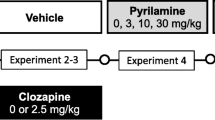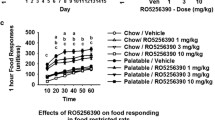Abstract
Experiment 1 showed that the reduction of intake produced by 5 or 10 mg/kg fluoxetine in rats eating either a solid or a liquid meal was partially antagonised by 1 mg/kg of the 5HT1/5HT2 antagonist metergoline but not by 1 mg/kg of the 5HT2 antagonist ketanserin. Experiment 2 examined the meal patterning of rats given 5 mg/kg fluoxetine and 1 mg/kg metergoline. Fluoxetine alone increased the latency to feed, reduced meal size and shifted the inter-pellet interval (IPI) distribution to the right. Metergoline alone had little immediate effect on food intake or other feeding parameters but partially reversed the reduction of food intake produced by fluoxetine. There was a complete reversal of the increased latency to feed and a partial reversal of the depression of meal size. However, the rightward shift of the IPI distribution caused by fluoxetine, which indicated a depression of feeding rate, was more pronounced after combined treatment. We conclude that fluoxetine reduces food intake by enhancing satiety through a serotonergic dependent mechanism but reduces feeding rate through a separate mechanism, whose neurochemical basis remains to be established.
Similar content being viewed by others
References
Berendsen HHG, Jenck F, Broeckkamp CLE 1990 Involvement of 5HT1c receptors in drug-induced penile erections in rats. Psychopharmacology 101:57–61
Blundell JE, Latham CJ (1980) Characterisation of adjustments to the structure of feeding behaviour following pharmacological treatment: effects of amphetamine and fenfluramine and the antagonism produced by pimozide and methergoline. Pharmacol Biochem Behav 12:717–722
Clifton PG (1987) Analysis of feeding and drinking patterns. In: Rowland N, Toates F (eds) Methods and techniques to study feeding and drinking behaviour. Elsevier, Amsterdam, pp 19–35
Clifton PG, Barnfield AMC, Philcox L (1989) A behavioural profile of fluoxetine-induced anorexia. Psychopharmacology 97:89–95
Davis JD, Collins BJ, Levine MW (1978) The interaction between gustatory stimulation and gut feedback in the control of the ingestion of liquid diets. In: Booth DA (ed) Hunger models. Academic Press, London, pp 109–142
Dourish CT, Clark ML, Fletcher A, Iversen SD (1989) Evidence that blockade of post-synaptic 5HT1 receptors elicits feeding in satiated rats. Psychopharmacology 97:54–58
Dumont C, Laurent J, Grandadam A, Boissier JR (1981) Anorectic properties of a new long acting serotonin uptake inhibitor. Life Sci 28:1939–1945
Garattini S, Mennini T, Beuclotti C, Invernizzi R, Samanin R (1986) Neurochemical mechanism of action of drugs which modify feeding via the serotonergic system. Appetite 7:15–38
Hewson G, Leighton GE, Hill RG, Hughes J (1988) Quipazine reduces food intake in the rat by activation of 5HT2 receptors. Br J Pharmacol 95:598–604
Hewson G, Leighton GE, Hill RG, Hughes J (1988) Ketanserin antagonises the anorectic effect of DL-fenfluramine in the rat. Eur J Pharmacol 145:227–230
Kennett GA, Curzon G (1988) Evidence that mCPP may have behavioural effects mediated by central 5HT1c receptors. Br J Pharmacol 94:137–147
Montgomery SA, Dufour H, Brion S, Gailledreau J, Laqueille X, Ferrey G, Moron P, Parant-Lucena N, Singer L, Danion JM, Beuzen JN, Perredon MA (1988) The prophylactic efficacy of fluoxetine in unipolar depression. Br J Psychiatry 153 [suppl 3]:69–76
Neill JC, Cooper SJ (1989) Evidence thatd-fenfluramine anorexia is mediated by 5HT1 receptors. Psychopharmacology 97:213–218
Samanin R, Ghezzi D, Valzelli L, Garratini S (1989) Evidence that central 5HT2 receptors do not play an important role in the anorectic activity of d-fenfluramine in the rat. Neuropharmacology 28:465–469
Siegel S, Castellan NJ (1988) Nonparametric statistics for the behavioural sciences, 2nd edn. McGraw Hill, New York
Willner P, McGuirk J, Phillips G, Muscat R (1990) Behavioural analysis of the anorectic effects of fluoxetine and fenfluramine. Psychopharmacology 102:273–277
Wong DT, Bymaster FP, Horng JS, Molloy BB (1975) A new selective inhibitor of uptake of serotonin into synaptosomes of rat brain: 3-(p-trifluoromethylphenoxy)-N-methyl-3-phenylpropylamine. J Pharmacol Exp Ther 193:804–811
Wong DT, Reid LR, Threlkeld PG (1988) Suppression of food intake in rats by fluoxetine: comparison of enantiomers and effects of serotonin antagonists. Pharmacol Biochem Behav 31:475–479
Author information
Authors and Affiliations
Rights and permissions
About this article
Cite this article
Lee, M.D., Clifton, P.G. Partial reversal of fluoxetine anorexia by the 5-HT antagonist metergoline. Psychopharmacology 107, 359–364 (1992). https://doi.org/10.1007/BF02245162
Received:
Revised:
Issue Date:
DOI: https://doi.org/10.1007/BF02245162




